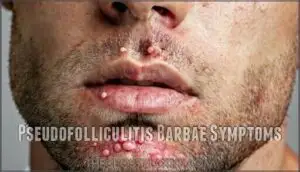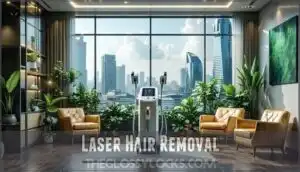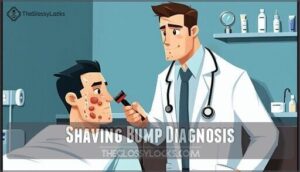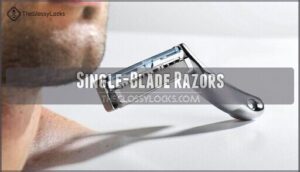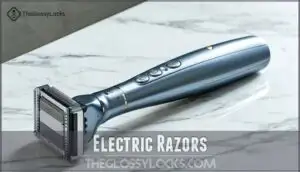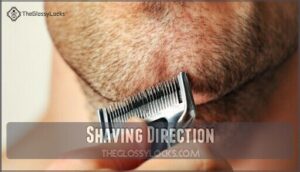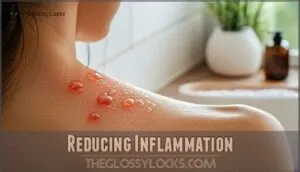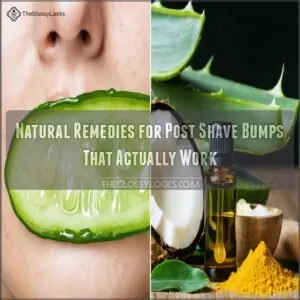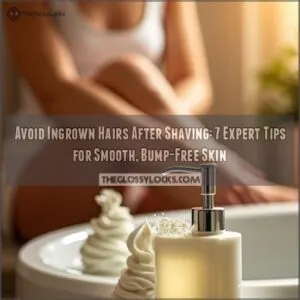This site is supported by our readers. We may earn a commission, at no cost to you, if you purchase through links.
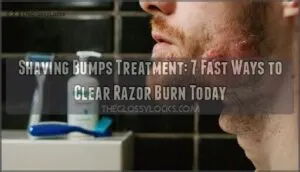
Start with salicylic acid or glycolic acid to unclog pores and reduce inflammation. Apply a warm compress for 5-10 minutes to soften the area, then gently exfoliate with a soft brush.
Aloe vera soothes irritated skin, while over-the-counter hydrocortisone cream tackles redness. Don’t pick or squeeze – you’ll make things worse.
Prevention beats treatment every time: use a sharp single-blade razor, shave with the grain, and prep your skin properly. Ready to transform your shaving routine from nightmare to smooth sailing?
Table Of Contents
- Key Takeaways
- Shaving Bumps Causes
- Pseudofolliculitis Barbae Symptoms
- Shaving Bump Prevention
- Razor Bump Treatment
- Home Remedies Relief
- Shaving Bump Diagnosis
- Shaving Techniques Matter
- Reducing Inflammation
- Long-Term Solutions
- Managing Razor Bumps
- Frequently Asked Questions (FAQs)
- How do you get rid of razor bumps?
- What should I do if I get a bump after shaving?
- How to prevent razor bumps when shaving?
- How do you treat razor bumps in the pubic area?
- How do you get rid of razor bumps in the shower?
- Do shaved hairs cause bumps?
- Does putting vaseline on razor bumps help?
- What is the best way to remove face bumps?
- How to prevent Red shave bumps?
- Should you shave if you have razor bumps?
- Conclusion
Key Takeaways
- Stop shaving immediately when bumps appear and let your skin heal completely – continuing to shave over inflamed areas worsens irritation and delays recovery.
- Use salicylic acid daily to exfoliate dead skin cells and free trapped hairs, combined with warm compresses twice daily to open pores and reduce inflammation.
- Switch to single-blade razors and shave with the grain using proper technique – multi-blade razors cut hair too close, creating sharp tips that easily re-enter your skin.
- Apply targeted treatments like aloe vera gel for soothing relief, hydrocortisone cream for inflammation, or consider prescription options for severe cases that don’t respond to over-the-counter solutions.
Shaving Bumps Causes
Shaving bumps develop when your hair follicles become inflamed after hair removal, creating those familiar red, irritated bumps on your skin.
You’re more likely to experience this condition if you have curly or coarse hair, shave too closely, or use improper shaving techniques that cause hairs to grow back into your skin instead of outward, leading to inflamed hair follicles.
Ingrown Hairs
Ingrown hairs happen when freshly shaved hair curls back into your hair follicle, creating immediate skin irritation.
These stubborn strands grow sideways instead of upward, triggering painful inflammation that leads to razor burn.
Ingrown symptoms include:
- Burning pain that makes you wince when touched
- Red, angry bumps that scream for attention
- Trapped hair visible beneath your skin’s surface
- Pus-filled spots resembling stubborn pimples
- Dark patches from repeated ingrown hair episodes
Curly Hair Texture
Your hair texture plays a major role in shaving bumps development. Curly hair naturally curves back into follicles after cutting, creating ingrown hair removal challenges. Those with tighter curl patterns face 45-85% higher pseudofolliculitis barbae PFB risk.
Curly hair’s natural tendency to curve back creates the perfect storm for razor bumps.
| Hair Factor | Impact on Bumps |
|---|---|
| Type 4 curls | Highest risk for shaving rash solution needs |
| Hair porosity | Affects texture management success |
| Coarse strands | Increase follicle penetration |
| Natural oils | Influence hair care requirements |
| Growth direction | Determines curly tips emergence |
Understanding your curly hair characteristics helps you choose appropriate shaving bumps treatment strategies.
Close Shaving
Aggressive close shaving creates the perfect storm for shaving bumps treatment needs.
When razors cut hair below skin level, they form razor-sharp tips that easily puncture back through your skin.
Shave frequency matters—daily shavers face higher bump prevention challenges.
Skin preparation with warm water and quality cream softens follicles, while adjusting your close shave technique reduces razor burn relief requirements.
Sharp blades and proper razor care prevent tugging that worsens inflammation.
Hair Removal Methods
Beyond traditional shaving, several hair removal techniques can trigger razor bumps and ingrown hairs. You’ll want to understand how each method affects your follicles differently.
Waxing tips suggest this method pulls hair from roots, creating sharp regrowth points that easily penetrate skin sideways. Sugaring offers gentler removal but still risks follicle irritation. Threading precisely removes facial hair but may inflame sensitive areas. Epilator devices mechanically pluck multiple hairs simultaneously, increasing trauma risk. Depilation creams dissolve hair proteins chemically but can irritate skin barriers.
These hair removal techniques share common risks for ingrown hair treatment needs:
- Root disruption creates sharper regrowth edges
- Follicle inflammation increases bump formation
- Dead skin buildup traps emerging hairs
- Sensitive skin reacts more severely
- Improper aftercare worsens complications
Understanding the causes of ingrown hair issues is essential for effective prevention and treatment.
Smart shaving techniques and ingrown hair prevention start with understanding your chosen method’s specific challenges.
Pseudofolliculitis Barbae Symptoms
You’ll recognize pseudofolliculitis barbae symptoms as small, raised bumps that appear 1-3 days after shaving, typically measuring 2-5 millimeters and feeling firm to the touch.
These inflamed papules often contain visible trapped hairs beneath the skin and may cause itching, tenderness, or pain when you touch the affected area, which can be described as pseudofolliculitis barbae.
Cost-Benefit Analysis
Breaking down Treatment Costs for razor bumps reveals stark differences in your Economic Impact.
Over-the-counter options like salicylic acid cost $5-25, while prescription antibacterial lotions run $15-60. Laser hair removal averages $306 per session but offers permanent results.
Prevention Strategies through proper technique cost virtually nothing yet prevent costly complications. Veterans may qualify for 30% disability ratings worth $537 monthly.
Smart Resource Allocation means weighing upfront costs against long-term Financial Burden for effective ingrown hair treatment. Veterans can explore VA rating options to determine their eligibility for benefits related to razor bumps.
Resource Allocation Challenges
Managing pseudofolliculitis barbae involves addressing significant resource allocation challenges that affect treatment decisions.
Many patients struggle with budget planning when deciding between immediate relief and thorough care strategies.
Cost optimization becomes vital when facing these financial barriers:
- Limited insurance coverage for specialized razor bumps treatments and laser procedures
- Higher costs of prescription bump reducer medications versus over-the-counter alternatives
- Geographic disparities in accessing dermatologists who understand shaving irritation nuances
Smart resource management means weighing immediate ingrown hair cure options against long-term allocation strategies.
You’ll need to balance funding priorities between prevention products and treatment solutions while considering your skin irritation severity and frequency of flare-ups.
Impact on Communities
Pseudofolliculitis barbae creates significant Social Stigma within affected communities, particularly among African-American men where razor bumps appear most frequently.
This condition generates substantial Economic Burden through missed work opportunities and medical costs.
Community Support networks help address skin irritation concerns, while Public Education programs promote Cultural Awareness about ingrown hair cure options and folliculitis barbae management strategies.
Shaving Bump Prevention
You can prevent most shaving bumps by using proper technique, quality tools, and the right preparation.
The key is creating conditions that allow hair to be cut cleanly without forcing it back into the follicle where it can become trapped and inflamed.
Proper Shaving Technique
Transform your shaving technique to break free from razor bumps and ingrown hair frustration.
Master these five essential Shaving Prep steps:
- Soften hair with warm water for 2-3 minutes
- Maintain proper Razor Angle at 30 degrees
- Apply quality Shave Gels for lubrication
- Avoid excessive Skin Tension while shaving
- Verify Blade Sharpness by replacing after 5-7 uses
Shave with the grain using short, gentle strokes.
This razor burn treatment approach prevents pseudofolliculitis barbae while delivering smooth results.
Shaving Cream Importance
Your shaving cream acts as your skin’s bodyguard against razor bumps.
Quality shaving cream with skin soothers like aloe creates a protective barrier that prevents shaving rash.
Different cream types offer varying protection levels.
Choosing the right shaving cream products with proper shaving cream can make a significant difference in preventing razor burns.
| Cream Types | Foaming Agents | Lubricants |
|---|---|---|
| Shaving Gel | Dense foam | High glycerin |
| Traditional cream | Moderate lather | Natural oils |
| Skin Soothing Cream | Minimal foam | Aloe vera base |
Choose products with moisturizing lubricants over cheap drugstore foam.
Your ingrown hair solution starts with proper cream selection.
Razor Blade Quality
Quality razor blades directly impact your fight against razor bumps and ingrown hairs. Dull blades require multiple passes, increasing skin trauma and inflammation risk.
Blade sharpness optimization requires:
- Replace blades every 5-7 shaves for consistent edge retention
- Select razor materials with premium steel construction
- Choose blade coating options like platinum or titanium for smoother glides
- Prioritize handle ergonomics for precise control during razor burn prevention
Sharp blades cut hair cleanly at skin level, preventing the curling that creates shaving bumps.
Razor Bump Treatment
When razor bumps develop, you’ll need targeted treatments to reduce inflammation and prevent infection.
The most effective approaches include antimicrobial creams that fight bacteria and laser hair removal for long-term prevention.
Antimicrobial Creams
Bacterial complications can turn simple razor bumps into painful skin infections that demand targeted intervention.
Topical antibiotics like clindamycin or erythromycin tackle folliculitis barbae by eliminating harmful bacteria while reducing inflammation.
Antibiotic ointments containing these antimicrobials work best when applied twice daily to clean, dry skin.
Watch for bacterial resistance signs like worsening redness or pus formation.
Cream ingredients may cause mild dryness, so start with once-daily application if you have sensitive skin.
These topical treatments effectively manage pseudofolliculitis barbae complications when home remedies fall short.
Using antimicrobial creams can be an essential step in preventing further infection.
Laser Hair Removal
Beyond antimicrobial creams, laser hair removal provides a transformative approach to conquering chronic razor bumps. This advanced technology targets hair follicles with concentrated light energy, achieving permanent removal by causing follicle destruction at the cellular level.
Clinical studies demonstrate that laser therapy delivers remarkable hair reduction results:
- Over 50% improvement in pseudofolliculitis barbae after three treatments
- 6-8 sessions typically required for maximum skin rejuvenation
- Nd:YAG lasers safely treat darker skin tones without pigmentation risks
- Long-term relief from ingrown hairs and chronic skin irritation
Professional laser treatment eliminates the root cause of folliculitis barbae, offering lasting freedom from daily shaving struggles. By utilizing laser hair removal techniques, individuals can achieve smoother skin and reduced ingrown hairs.
Home Remedies Relief
You’ll find relief right at home with natural remedies that actually work for razor bumps.
These gentle treatments can soothe inflammation and help ingrown hairs break free without harsh chemicals or expensive visits to the dermatologist, providing a solution that is both effective and gentle.
Aloe Vera Application
Nature’s most trusted remedy sits waiting in aloe vera gel. You’ll discover immediate relief when applying this Natural Remedies solution to angry razor bumps.
The Vera Extract delivers powerful Skin Soothing properties that calm inflamed follicles while accelerating healing.
| Aloe Gel Benefits | Application Method | Expected Results |
|---|---|---|
| Anti-inflammatory | Fresh leaf gel | Reduced redness |
| Antimicrobial | Pure bottled gel | Cleaner pores |
| Cooling relief | Refrigerated treatment | Instant comfort |
Apply Aloe Treatment twice daily for ideal skin irritation cure results.
Using aloe vera pre shave routines can enhance the overall shaving experience and reduce irritation.
Baking Soda Paste
Against this backdrop of simple home remedies, baking soda paste delivers remarkable skin soothing power for razor bumps.
You’ll create the paste by mixing two tablespoons baking soda with water until thick. Apply this mixture to affected areas, letting it sit for ten minutes before gentle removal.
The exfoliating properties help lift ingrown hairs while reducing skin irritation. This natural remedy offers paste benefits that rival commercial treatments for folliculitis barbae.
Calendula Cream
Calendula cream delivers anti-inflammatory properties that target razor bumps directly at the source.
You’ll notice this herbal remedy soothes skin irritation prevention within hours of application. Apply calendula benefits twice daily for ideal cream applications results.
This natural ointment promotes healing while reducing redness from ingrown hairs. Many find significant improvement in their shaving bumps treatment using these herbal remedies consistently over 2-3 days.
Shaving Bump Diagnosis
When you suspect razor bumps, your doctor will likely perform a simple visual examination of the affected area.
In cases where infection is suspected, they might collect a skin culture to identify specific bacteria and rule out conditions like folliculitis or fungal infections.
Physical Examination
Your doctor’s clinical assessment reveals the full picture of your razor bump situation.
During a skin examination, they’ll perform visual skin inspection and gentle palpation to evaluate inflammation levels and bump assessment.
Using dermoscopy, dermatologists conduct thorough follicle checks to identify trapped ingrown hairs beneath the surface.
This dermatological review distinguishes pseudofolliculitis barbae from similar conditions like folliculitis barbae, ensuring accurate diagnosis.
The examination assesses lesion characteristics, distribution patterns, and severity levels to determine ideal treatment approaches for your specific razor bumps condition.
Skin Cultures
When physical examination proves inconclusive, dermatologists may order skin cultures to identify specific pathogens complicating your razor bumps.
These tests detect bacterial infections like Staphylococcus aureus or fungal organisms such as Malassezia species that worsen pseudofolliculitis barbae.
Skin cultures guide targeted antimicrobial therapy, helping distinguish infectious folliculitis barbae from simple ingrown hairs.
This dermatological approach guarantees proper follicle care across different skin types and hair texture variations.
Differential Diagnosis
Accurate differential diagnosis guarantees you receive proper treatment for your razor bumps rather than mismatched remedies.
Your doctor systematically rules out conditions that mimic pseudofolliculitis barbae through careful clinical evaluation. This diagnostic criteria approach prevents unnecessary treatments and complications.
Medical tests help distinguish razor bumps from similar skin conditions:
- Folliculitis barbae – bacterial infection requiring antibiotic treatment
- Tinea barbae – fungal infection needing antifungal medication
- Acne vulgaris – comedonal lesions with different inflammatory patterns
- Cutaneous sarcoidosis – systemic condition with distinct tissue changes.
This differential analysis protects you from ineffective ingrown hair treatments.
Shaving Techniques Matter
The right shaving technique can make the difference between smooth skin and painful bumps that last for weeks.
Your choice of razor type and shaving direction directly impacts whether hair grows back normally or becomes trapped under your skin.
Single-Blade Razors
After diagnosing razor bumps, switching to single-blade razors offers your strongest defense against recurring irritation.
Single blade razors reduce ingrown hair solutions by cutting hair cleanly at skin level, preventing the lift-and-cut action that traps hairs beneath the surface. Razor sharpness matters—replace blades after 5-7 uses to maintain peak cutting performance.
| Feature | Benefit |
|---|---|
| Blade Material | Sharp steel cuts cleanly without tugging |
| Safety Features | Guards protect against excessive pressure |
| Shaving Angles | 30-degree angle prevents hair re-entry |
Proper razor maintenance includes thorough cleaning and dry storage to prevent bacterial growth. Your technique controls the outcome—use light pressure and let the razor’s weight guide the blade, minimizing friction that causes razor burn.
Electric Razors
Electric razors provide a safer alternative for those battling razor bumps and ingrown hair solutions. Unlike traditional blades, these devices maintain distance between cutting elements and skin, reducing irritation that leads to shaving bumps treatment needs.
Modern cordless options offer freedom of movement while built-in safety features protect sensitive areas. Quality electric shaving requires proper razor maintenance – clean heads after each use and follow blade replacement schedules. Many models include adjustable settings for different skin sensitivities.
Consider these electric razor benefits for razor burn cream alternatives:
- Reduced skin contact minimizes friction and inflammation risk
- Consistent cutting height prevents hairs from being cut too short
- Built-in guards block direct blade-to-skin contact
- Adjustable speed settings accommodate sensitive skin needs
- Easy cleaning systems maintain hygiene and performance
Shaving Direction
Shaving direction matters more than you think. Always shave with your hair growth pattern, not against it.
This simple rule prevents most razor bumps and razor burn. Map your hair’s natural flow first—especially on your neck where growth varies.
Keep skin tension light and use short strokes. Your razor glide should follow nature’s blueprint.
Proper shave angle and blade sharpness support this gentle approach, giving you smoother results without irritation.
Reducing Inflammation
When razor bumps flare up, you need targeted treatments that calm the inflammatory response quickly.
Chemical exfoliants and gentle mechanical removal work together to reduce swelling while clearing the path for trapped hairs to surface naturally, utilizing gentle methods to promote healing.
Salicylic Acid
Better shaving techniques help, but salicylic acid delivers real bump removal power. This beta-hydroxy acid acts like your skin’s personal janitor, sweeping away cellular debris that traps hairs.
Salicylic Benefits for razor bumps include:
- Skin exfoliation that unclogs blocked follicles
- Deep pore penetration to release ingrown hair
- Anti-inflammatory action reducing bump swelling
- Prevention of future folliculitis barbae outbreaks
You’ll find salicylic acid in cleansers, toners, and spot treatments. Start with 0.5-2% concentrations to avoid irritation. Acid treatment works best when applied twice daily to clean skin. Unlike harsh acid peels, over-the-counter formulas provide gentle yet effective shaving bumps treatment that won’t leave you looking like a lobster.
Glycolic Acid
Glycolic acid goes beyond surface-level treatment by penetrating deeper layers to reduce hair curvature and accelerate skin renewal.
This powerful acid exfoliation agent dissolves cellular bonds, preventing razor bumps from forming while reducing skin inflammation.
Apply glycolic acid products with 5-10% concentration to clean skin after shaving.
Chemical peels and facial treatments containing this ingredient deliver faster ingrown hair loosening results than surface treatments alone.
Mechanical Scrubs
Physical scrubbing breaks the cycle of trapped hairs that cause painful bumps. Exfoliating tools like skin brushes work by loosening dead skin cells that block follicles. Facial massagers paired with gentle cleansers enhance circulation while preventing further irritation.
Consider these effective skin brushing techniques:
- Use circular motions with soft bristles twice weekly
- Apply light pressure to avoid damaging inflamed areas
- Choose skin exfoliants containing alpha hydroxy acids
- Follow up with moisturizer to prevent overdrying
Proper exfoliation prevents dead skin removal from becoming counterproductive.
Long-Term Solutions
If you’re dealing with persistent razor bumps that keep coming back, it’s time to think about long-term treatment options that address the root cause.
Hair removal creams, depilatories, and prescription treatments can provide lasting relief by either removing hair completely or changing how it grows back into your skin.
Hair Removal Creams
When traditional methods fail you, chemical hair removal creams break the protein bonds holding hair together. These hair dissolvers eliminate sharp edges that create shaving bumps, offering gentler follicle care than razors.
Depilatories work within 4-10 minutes, dissolving hair at skin level. Depilatory effects last longer than shaving, giving irritated skin recovery time. Many users find these creams effective for hair removal.
| Cream Types | Skin Benefits |
|---|---|
| Sensitive Formula | Reduces burning sensation |
| Extra Strength | Tackles coarse, curly hair |
| Skin Soothers | Contains aloe, shea butter |
Clinical studies show 85% hair removal effectiveness with softer regrowth. You’ll experience fewer ingrown hairs since there’s no blade cutting hair at sharp angles. Hair removal techniques using creams prevent razor bumps formation while maintaining smooth results.
Depilatories
Unlike traditional razors, depilatories work by breaking down hair’s protein structure through chemical reactions. These chemical depilatories contain active depilatory ingredients like calcium thioglycolate or barium sulfide paste that dissolve hair below the surface.
Here’s how to use them safely:
- Always patch-test for skin sensitivity before full application
- Follow precise timing—leaving products on too long causes burns
- Master proper application techniques using gentle, even strokes
Consider these treatment alternatives when hair removal creams aren’t suitable for your skin type.
Prescription Treatments
When topical treatments aren’t cutting it, prescription treatments become your game-changer for severe cases.
Healthcare providers offer targeted solutions that work faster than over-the-counter options.
Your doctor may recommend:
- Topical steroids like hydrocortisone to calm inflammation quickly
- Oral antibiotics such as doxycycline for infected follicles
- Retinoid creams to prevent future ingrown hairs effectively
- Chemical peels with glycolic acid for stubborn bumps.
These corticosteroids deliver results when home remedies fall short.
Managing Razor Bumps
When you’re dealing with razor bumps, you need effective treatment options that work quickly without causing more irritation.
The right combination of gentle exfoliation, natural remedies, and over-the-counter treatments can help clear your skin and prevent future breakouts.
Gentle Exfoliation
Gentle exfoliation breaks the cycle of trapped hairs beneath your skin’s surface.
Start with salicylic acid or glycolic acid products twice weekly—these chemical exfoliants dissolve dead skin cells without harsh scrubbing. For sensitive skin, use a soft brush or washcloth daily with gentle circular motions.
Frequency matters: over-exfoliating causes irritation. Post-exfoliation care includes moisturizing immediately to prevent dryness and inflammation.
Understanding the importance of exfoliate to prevent razor burn is vital for effective shaving bump treatment.
smoother skin
Natural Remedies
Nature’s pharmacy offers proven solutions for razor bump relief.
Aloe vera gel delivers immediate cooling comfort while reducing inflammation. Tea tree oil, when properly diluted, provides antimicrobial protection against infected follicles.
Coconut oil’s natural anti-inflammatory compounds calm irritated skin without clogging pores. Create a baking soda paste to gently exfoliate trapped hairs.
These natural remedies work synergistically with your skin’s healing process, offering gentle yet effective relief from pseudofolliculitis barbae.
Over-The-Counter Creams
Over-the-counter medications provide reliable razor bump treatment when natural options aren’t enough.
Hydrocortisone cream delivers fast itch relief by reducing inflammation, while salicylic acid products work as effective bump reducers.
These skin soothers contain proven ingredients that target pseudofolliculitis barbae symptoms.
Cream benefits include antimicrobial protection and scar minimizers for long-term healing.
- Quick relief – Hydrocortisone cream soothes angry, inflamed bumps within hours
- Targeted action – Salicylic acid penetrates deep to free trapped hairs
- Gentle healing – Allantoin and aloe vera restore damaged skin barrier
- Confidence boost – Clear, smooth skin helps you face the day worry-free
Frequently Asked Questions (FAQs)
How do you get rid of razor bumps?
Breaking free from razor bumps requires a tactical retreat.
Stop shaving immediately and let your skin heal for several weeks.
Apply salicylic acid products daily to exfoliate dead skin cells and reduce inflammation.
Use warm compresses twice daily to help release trapped hairs naturally, which is a key step in preventing inflammation.
What should I do if I get a bump after shaving?
Stop shaving immediately and apply warm compresses twice daily to open pores and release trapped hairs. Use salicylic acid cleanser to exfoliate dead skin cells and prevent infection from developing.
How to prevent razor bumps when shaving?
John noticed persistent red bumps after every shave until he changed his technique.
You’ll prevent razor bumps by shaving with the grain, using single-blade razors, and applying warm compresses beforehand to soften hair and open follicles properly, which helps to prevent razor bumps.
How do you treat razor bumps in the pubic area?
Apply warm compresses twice daily to open pores and release trapped hairs.
Use salicylic acid cleansers to exfoliate dead skin cells.
Apply aloe vera gel to reduce inflammation and soothe irritated skin naturally.
How do you get rid of razor bumps in the shower?
Why suffer through the sting when your shower can become your sanctuary?
Gently exfoliate with a soft washcloth, use warm water to open pores, and apply salicylic acid cleanser to reduce inflammation and free trapped hairs effectively.
Do shaved hairs cause bumps?
Yes, shaved hairs can cause bumps when they curl back and re-enter your skin instead of growing outward. This creates inflammation and those irritating razor bumps you’re dealing with.
Does putting vaseline on razor bumps help?
Vaseline won’t cure your razor bumps, but it’ll moisturize irritated skin and create a protective barrier.
You’ll get better results with salicylic acid or glycolic acid treatments that actually address ingrown hairs.
What is the best way to remove face bumps?
Stop shaving first—it’s your fastest path to healing.
Gentle exfoliation with salicylic acid breaks down dead skin trapping hairs.
Topical steroids calm inflammation while retinoids speed cell turnover for clearer skin.
How to prevent Red shave bumps?
Avoid multiblade razors and shaving against the grain. Use single-blade or electric razors, shave with the grain, and apply pre-shave oil to soften hair before shaving.
Should you shave if you have razor bumps?
Give razor bumps the cold shoulder – absolutely don’t shave over them.
Continuing to shave inflamed pseudofolliculitis barbae worsens irritation, prolongs healing, and increases infection risk.
Let your skin recover completely first.
Conclusion
Picture razor bumps disappearing like morning mist – that’s your reality with consistent shaving bumps treatment.
You’ve learned seven proven methods to combat pseudofolliculitis barbae effectively. Whether you choose salicylic acid exfoliation, warm compresses, or proper razor technique, consistency remains key.
Don’t let razor bumps control your grooming routine anymore. Start implementing these evidence-based treatments today, and you’ll see clearer, healthier skin within days.
Your smooth, bump-free shave awaits, with consistent shaving bumps treatment being the path to achieving it.


